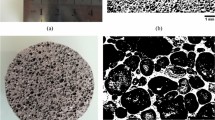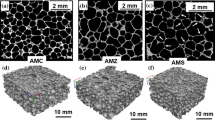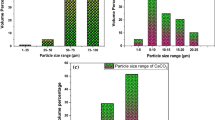Abstract
In this study, the effects of alloy elements, oxide phases, and created intermetallic compounds of aluminum alloy foams with different percentages of silicon, zinc, and combinations of both these elements were investigated on the compressive properties and fracture behavior of these foams. The results showed that the addition of alloying elements formed intermetallic compounds in the structure of the foam, and the number of intermetallic compounds increased with increasing the percentage of these elements which causes inconsistency between these compounds and base materials. All these factors changed the failure mechanism of these foams so that the failure behavior of pure aluminum foam and zinc-containing foams was a ductile failure, whereas the failure behaviors of silicon-containing foam samples were brittle. The Al–4%Si–4%Zn sample had the highest compressive strength among all of the fabricated samples due to the uniformly distributed intermetallic compounds in the cell wall of these samples, whereas the Al–8%Si, Al–8%Si–4%Zn, and Al–8%Si–8%Zn foam samples were more brittle than the other fabricated foam samples due to the more formation of brittle compounds such as CaAl2Si2 and their accumulation in a certain area which reduced the compressive strength of these foams. Also, it was observed that the energy absorption capacity and yield strength of pure aluminum foam generally increased with the addition of alloy elements due to the increase in the amount of created intermetallic compounds in the structure of these foams.
















Similar content being viewed by others
References
D.K. Rajak, M. Gupta, Applications of metallic foams, in An Insight Into Metal Based Foams. Springer. 21–37 (2020). https://doi.org/10.1007/978-981-15-9069-6_2
F. Binesh, J. Zamani, M. Ghiasvand, Ordered structure composite metal foams produced by casting. Inter Metalcast 12, 89–96 (2018). https://doi.org/10.1007/s40962-017-0143-x
F. García-Moreno, Commercial applications of metal foams: their properties and production. Materials (2016). https://doi.org/10.3390/ma9020085
L.P. Lefebvre, J. Banhart, D.C. Dunand, Porous metals and metallic foams: current status and recent developments. Adv. Eng. Mater. 10(9), 775–787 (2008). https://doi.org/10.1002/adem.200800241
J. Banhart, Aluminium foams for lighter vehicles. Int. J. Veh. Des. 37(2–3), 114–125 (2005). https://doi.org/10.1504/IJVD.2005.006640
K.S. Verma, D. Muchhala, S.K. Panthi et al., Influences of cell size, cell wall thickness and cell circularity on the compressive responses of closed-cell aluminum Foam and its FEA analysis. Inter Metalcast (2021). https://doi.org/10.1007/s40962-021-00627-2
K. Kadoi, H. Nakae, Relationship between foam stabilization and physical properties of particles on aluminum foam production. Mater. Trans. 1, 1 (2011). https://doi.org/10.2320/matertrans.F-M2011817
Ç. Bolat, İC. Akgün, A. Gökşenli, Effect of aging heat treatment on compressive characteristics of bimodal aluminum syntactic foams produced by cold chamber die casting. Inter Metalcast (2021). https://doi.org/10.1007/s40962-021-00629-0
F. Campana, D. Pilone, Effect of wall microstructure and morphometric parameters on the crush behaviour of Al alloy foams. Mater. Sci. Eng. A 479(1–2), 58–64 (2008). https://doi.org/10.1016/j.msea.2007.06.040
V. Jeenager, V. Pancholi, Influence of cell wall microstructure on the energy absorption capability of aluminium foam. Mater. Des. 1980–2015, 454–459 (2014). https://doi.org/10.1016/j.matdes.2013.08.109
L.Y. Aguirre-Perales, R.A. Drew, I.-H. Jung, The effect of in situ intermetallic formation on Al-Sn foaming behavior. Metall. Mater. Trans. A 1, 3714 (2014). https://doi.org/10.1007/s11661-014-2313-2
Y. Yamada et al., Compressive deformation behaviour of a closed-cell aluminum. Mater. Sci. Forum (2006). https://doi.org/10.4028/www.scientific.net/MSF.510-511.150
Y. Mu et al., Deformation mechanisms of closed-cell aluminum foam in compression. Scripta Mater. (2010). https://doi.org/10.1016/j.scriptamat.2010.05.041
X.-Q. Cao et al., Effects of cell size on compressive properties of aluminum foam. Trans. Nonferrous Met. Soc. China (2006). https://doi.org/10.1016/S1003-6326(06)60060-5
H.-W. Song et al., Fracture mechanisms and size effects of brittle metallic foams: In situ compression tests inside SEM. Compos. Sci. Technol. 68(12), 2441–2450 (2008). https://doi.org/10.1016/j.compscitech.2008.04.023
E. Maire et al., Recent results on 3D characterisation of microstructure and damage of metal matrix composites and a metallic foam using X-ray tomography. Mater. Sci. Eng. A 319, 216–219 (2001). https://doi.org/10.1016/S0921-5093(01)00924-8
A. Elmoutaouakkil et al., 2D and 3D characterization of metal foams using X-ray tomography. Adv. Eng. Mater. 4(10), 803–807 (2002). https://doi.org/10.1002/1527-2648(20021014)4:10%3c803::AID-ADEM803%3e3.0.CO;2-D
C. San Marchi, J.-F. Despois, A. Mortensen, Uniaxial deformation of open-cell aluminum foam: the role of internal damage. Acta Mater. 52(10), 2895–2902 (2004). https://doi.org/10.1016/j.actamat.2004.02.035
S. McDonald et al., Characterization of the three-dimensional structure of a metallic foam during compressive deformation. J. Microsc. 223(2), 150–158 (2006). https://doi.org/10.1111/j.1365-2818.2006.01607.x
A. Markaki, T. Clyne, The effect of cell wall microstructure on the deformation and fracture of aluminium-based foams. Acta Mater. 49(9), 1677–1686 (2001)
H.-J. Yu, G.-C. Yao, Y.-H. Liu, Tensile property of Al-Si closed-cell aluminum foam. Trans. Nonferrous Met. Soc. China 16(6), 1335–1340 (2006)
T. Savaşkan, A. Aydıner, Effects of silicon content on the mechanical and tribological properties of monotectoid-based zinc–aluminium–silicon alloys. Wear 257(3–4), 377–388 (2004). https://doi.org/10.1016/j.wear.2004.01.007
B. Prasad, Tensile properties of some zinc-based alloys comprising 2.75% Al: effects of alloy microstructure, composition and test conditions. Mater. Sci. Eng. A 245(2), 257–266 (1998). https://doi.org/10.1016/S0921-5093(97)00723-5
B. Prasad, A. Patwardhan, A. Yegneswaran, Dry sliding wear characteristics of some zinc-aluminium alloys: a comparative study with a conventional bearing bronze at a slow speed. Wear 199(1), 142–151 (1996). https://doi.org/10.1016/0043-1648(96)07231-6
H. Gao, C. **ong, J. Yin et al., Research on dynamic accumulation effect and constitutive model of aluminum foams under dynamic impact. Inter Metalcast 13, 146–157 (2019). https://doi.org/10.1007/s40962-018-0245-0
X. **a et al., Compressive properties of closed-cell aluminum foams with different contents of ceramic microspheres. Mater. Des. 1980–2015(56), 353–358 (2014). https://doi.org/10.1016/j.matdes.2013.11.040
J.K. Khabushan et al., A study of fabricating and compressive properties of cellular Al–Si (355.0) foam using TiH2. Mater. Des. 55, 792–797 (2014). https://doi.org/10.1016/j.matdes.2013.10.022
X. **a et al., The compressive properties of closed-cell aluminum foams with different Mn additions. Mater. Des. (2013). https://doi.org/10.1016/j.matdes.2013.11.040
T. Mukai et al., Compressive response of a closed-cell aluminum foam at high strain rate. Scr. Mater. 54(4), 533–537 (2006). https://doi.org/10.1016/j.scriptamat.2005.10.062
M.R. Farahani, H.R.R. Ashtiani, S. Elahi, Effect of silicon content on mechanical properties and progressive collapse behavior of closed-cell aluminum foams. Trans. Indian Inst. Metals 74, 3145–3154 (2021). https://doi.org/10.1007/s12666-021-02390-8
M.R. Farahani, H.R. Rezaei Ashtiani, S.H. Elahi, Effect of zinc content on the mechanical properties of closed-cell aluminum foams. Inter Metalcast 16, 713–722 (2022). https://doi.org/10.1007/s40962-021-00635-2
M.R. Farahani, H.R. Rezaei Ashtiani, S.H. Elahi, The effect of adding silicon and zinc elements on the mechanical properties of closed-cell aluminum-based foams. Inter Metalcast (2022). https://doi.org/10.1007/s40962-022-00827-4
W. Deqing et al., Cell structure and compressive behavior of an aluminum foam. J. Mater. Sci. 40(13), 3475–3480 (2005). https://doi.org/10.1007/s10853-005-2852-4
A. Bastawros, H. Bart-Smith, A. Evans, Experimental analysis of deformation mechanisms in a closed-cell aluminum alloy foam. J. Mech. Phys. Solids 48(2), 301–322 (2000). https://doi.org/10.1016/S0022-5096(99)00035-6
A. Simone, L. Gibson, The effects of cell face curvature and corrugations on the stiffness and strength of metallic foams. Acta Mater. 46(11), 3929–3935 (1998). https://doi.org/10.1016/S1359-6454(98)00072-X
A.M. Kraynik et al., Foam Micromechanics (Sandia National Laboratories, Albuquerque, 1998)
B.Y. Hur, S.H. Park, A. Hiroshi, Viscosity and surface tension of Al and effects of additional element. Mater. Sci. Forum (2003). https://doi.org/10.4028/www.scientific.net/MSF.439.51
D.-W. Li et al., Preparation and characterization of aluminum foams with ZrH2 as foaming agent. Trans. Nonferrous Met. Soc. China 21(2), 346–352 (2011). https://doi.org/10.1016/S1003-6326(11)60720-6
M.H. Ghaleh, N. Ehsani, H.R. Baharvandi, High-porosity closed-cell aluminum foams produced by melting method without stabilizer particles. Inter Metalcast 15, 899–905 (2021). https://doi.org/10.1007/s40962-020-00528-w
A. Haibel, A. Rack, J. Banhart, Why are metal foams stable? Appl. Phys. Lett. 89(15), 154102 (2006). https://doi.org/10.1063/1.2357931
J. Banhart, Metal foams: production and stability. Adv. Eng. Mater. 8(9), 781–794 (2006). https://doi.org/10.1002/adem.200600071
C. Körner, M. Arnold, R.F. Singer, Metal foam stabilization by oxide network particles. Mater. Sci. Eng. A 396(1–2), 28–40 (2005). https://doi.org/10.1016/j.msea.2005.01.001
A. Ibrahim, Effect of material and processing parameters on the morphology of aluminium foams produced by the PM route (2005).
J.R. Davis, Aluminum and Aluminum Alloys (ASM International, London, 1993)
J. Banhart, Manufacture, characterisation and application of cellular metals and metal foams. Prog. Mater Sci. 46(6), 559–632 (2001). https://doi.org/10.1016/S0079-6425(00)00002-5
W. Poole, E. Dowdle, Experimental measurements of damage evolution in Al-Si eutectic alloys. Scripta Mater. (1998). https://doi.org/10.1016/S1359-6462(98)00326-1
M. Kiser, F. Zok, D. Wilkinson, Plastic flow and fracture of a particulate metal matrix composite. Acta Mater. 44(9), 3465–3476 (1996). https://doi.org/10.1016/1359-6454(96)00028-6
W. Hunt Jr., J. Brockenbrough, P. Magnusen, An Al-Si-Mg composite model system: microstructural effects on deformation and damage evolution. Scr. Metall. Mater. 25(1), 15–20 (1991). https://doi.org/10.1016/0956-716X(91)90346-3
H. Toda et al., Quantitative assessment of microstructure and its effects on compression behavior of aluminum foams via high-resolution synchrotron X-ray tomography. Metall. Mater. Trans. A. 37(4), 1211–1219 (2006). https://doi.org/10.1007/s11661-006-1072-0
R.E. Raj, B. Daniel, Manufacturing challenges in obtaining tailor-made closed-cell structures in metallic foams. Int. J. Adv. Manuf. Technol. 38(5), 605–612 (2008). https://doi.org/10.1007/s00170-007-1254-y
Author information
Authors and Affiliations
Corresponding author
Additional information
Publisher's Note
Springer Nature remains neutral with regard to jurisdictional claims in published maps and institutional affiliations.
Rights and permissions
Springer Nature or its licensor (e.g. a society or other partner) holds exclusive rights to this article under a publishing agreement with the author(s) or other rightsholder(s); author self-archiving of the accepted manuscript version of this article is solely governed by the terms of such publishing agreement and applicable law.
About this article
Cite this article
Farahani, M.R., Rezaei Ashtiani, H.R. & Elahi, S. Effect of Intermetallic Phases and Compounds on the Compressive Behavior and Fracture Mechanism of Al–Si–Zn Foams. Inter Metalcast 18, 403–416 (2024). https://doi.org/10.1007/s40962-023-01027-4
Received:
Accepted:
Published:
Issue Date:
DOI: https://doi.org/10.1007/s40962-023-01027-4




